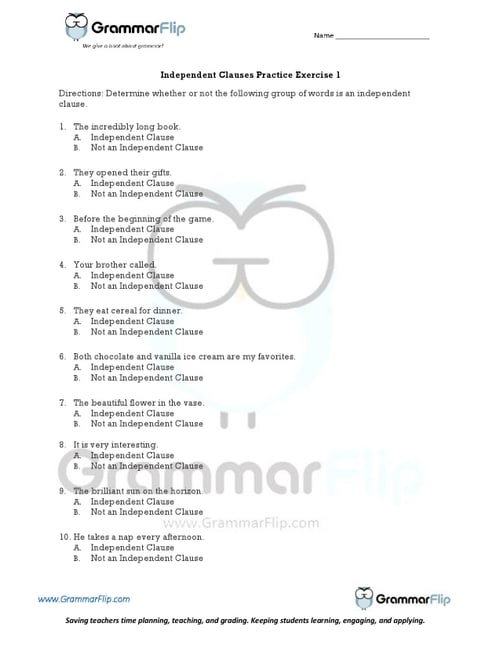What is an Independent Clause?
An independent clause contains both a subject and a verb, completes a thought, and must be able to stand on its own as a complete sentence.
Some examples of independent clauses would be the following:
Garrett reads detective novels.
Kate threw a surprise party.
The biker glided down the hill.
We baked brownies.
Long-Form Video: Independent Clauses
Long-form instructional video lessons allow students to engage with grammar concepts in more depth and detail.
This format provides students with a stronger foundation and a more comprehensive understanding of independent clauses.
What to Know About Independent Clauses
Understanding independent clauses might best be explained by comparing them to dependent clauses. While both independent clauses and dependent clauses contain a subject and a verb, independent clauses can stand alone and complete a thought while dependent clauses cannot. In other words, independent clauses are complete sentences.
Don’t be distracted by short sentences or commands that might make you think they are not complete thoughts. They are still independent clauses! Consider the following two sentences:
I ran.
I = subject, ran = verb
Go.
(Understood You) = Subject, Go = Verb
Notice both sentences have a subject and a verb, and both complete a thought; therefore, they are independent clauses.
Once you have a solid understanding of independent clauses (and how they are different from dependent clauses), be sure to explore noun clauses, adjective clauses, adverb clauses, and elliptical clauses!
Download a Free Worksheet on Independent Clauses!
Click the image below to download your free worksheet on independent clauses!

How well do your students understand independent clauses?
Explore More GrammarFlip Lessons!
Parts of Speech lessons provide the building blocks of grammar. GrammarFlip covers these topics in detail to ensure a solid foundation is built. First time learners and students seeking to review the parts of speech can both benefit from the instructional videos and slide show reviews.
Parts of the Sentence lessons are critical for understanding how the parts of speech function in language construction. From the basic to the advanced, these lessons will cover a wide range of grammar topics that can be used in any grade level or classroom.
Mechanics and Usage lessons equip students with the necessary skills to communicate clearly to all audiences. With a focus on the application of these concepts in student writing, these lessons tie together both simple constructions of grammar as well as the more complex such that any age or skill level of student will benefit.

